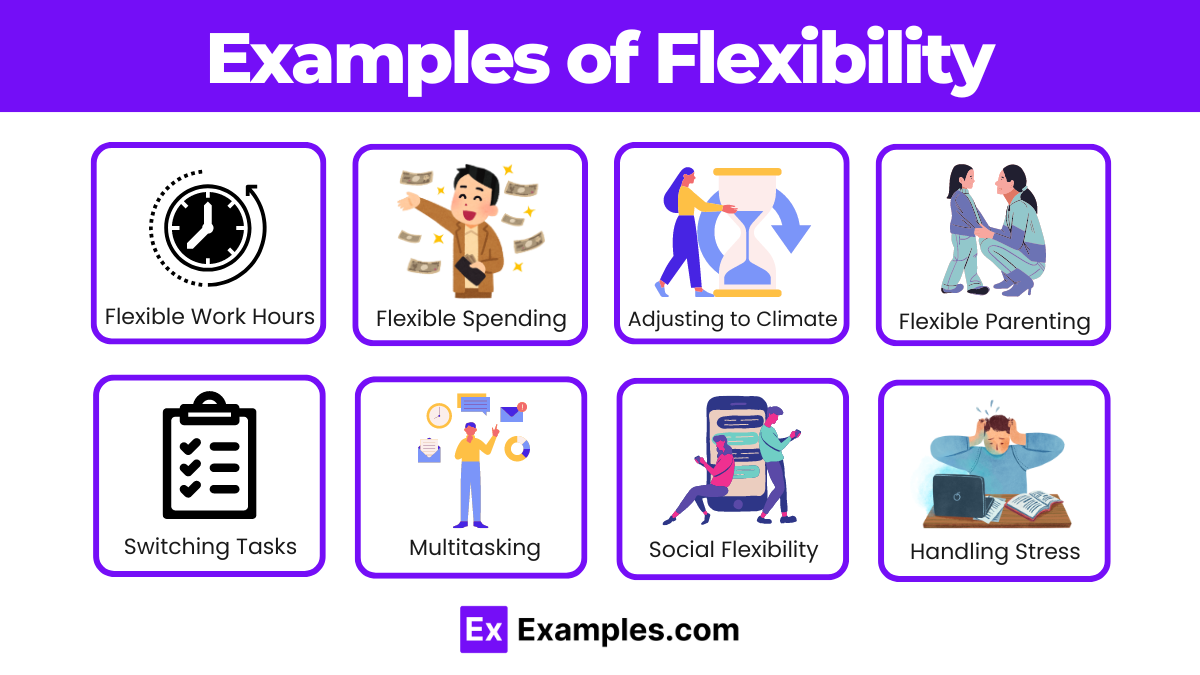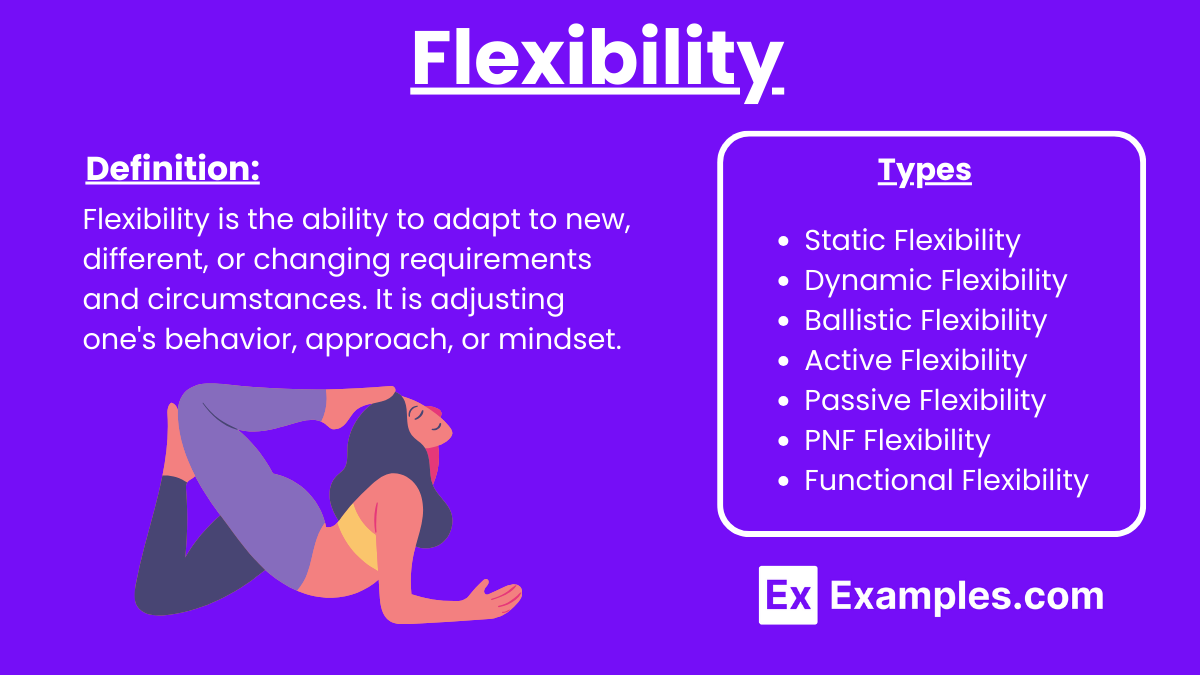30+ Flexibility Examples
Flexibility is the ability to adapt and respond to changing circumstances effectively. It plays a crucial role in both personal and professional settings. Implementing a Flexible Workplace Policy and Procedures can significantly enhance employee satisfaction and productivity. In personal fitness, setting Fitness Goals to Start Right and maintaining a Fitness Journal can provide structure and motivation for a successful fitness journey.
What is Flexibility?
Flexibility is the capacity to adapt swiftly to new, different, or changing requirements. It involves being able to adjust to varying circumstances and demands with ease and efficiency.
Examples of Flexibility

- Adapting to Remote Work: Quickly adjusting to working from home.
- Flexible Work Hours: Allowing employees to choose their working hours.
- Switching Tasks: Easily moving from one task to another.
- Learning New Skills: Being open to acquiring new competencies.
- Handling Unexpected Changes: Managing sudden alterations in plans smoothly.
- Adjusting Fitness Routines: Modifying workout plans to fit changing schedules.
- Flexible Diet Plans: Altering meal plans based on availability and preferences.
- Multitasking: Juggling multiple responsibilities effectively.
- Adapting to New Technologies: Quickly learning to use new tools and software.
- Changing Travel Plans: Rescheduling trips with minimal disruption.
- Flexible Parenting: Adapting parenting styles to suit different child behaviors.
- Balancing Work and Life: Adjusting personal and professional priorities as needed.
- Accepting Feedback: Being open to constructive criticism and using it for improvement.
- Relocating for Work: Moving to a new location for job opportunities.
- Changing Career Paths: Transitioning to a different field or industry.
- Managing Finances: Adjusting budgets in response to financial changes.
- Social Flexibility: Adapting to different social situations and groups.
- Creative Problem-Solving: Finding innovative solutions to unexpected problems.
- Adapting Study Habits: Changing study routines to improve learning efficiency.
- Flexible Vacation Planning: Adjusting holiday plans based on circumstances.
- Flexible Learning Environments: Adapting to various learning settings, such as online or in-person.
- Negotiating Schedules: Adjusting meeting times to accommodate all parties.
- Adjusting to Climate: Adapting to different weather conditions.
- Changing Fitness Goals: Modifying fitness objectives based on progress or setbacks.
- Handling Stress: Managing stress by altering coping strategies.
- Adaptable Communication: Changing communication styles to fit different audiences.
- Flexible Teaching Methods: Adapting instructional techniques to meet students’ needs.
- Adjusting Expectations: Modifying goals and expectations in response to reality.
- Flexible Spending: Adjusting expenditure based on income fluctuations.
- Adapting Relationships: Changing dynamics in personal relationships to maintain harmony.
Types of Flexibility
1. Static Flexibility
Static flexibility refers to the range of motion around a joint during a passive movement. It involves holding a stretch without movement, allowing muscles to lengthen. This type of flexibility is typically measured by the distance a joint can move in a fixed position.
Examples:
- Touching your toes while keeping your legs straight.
- Holding a seated forward bend in yoga.
2. Dynamic Flexibility
Dynamic flexibility involves the ability to move muscles and joints through their full range of motion during active movements. It is crucial for activities that require quick and powerful movements.
Examples:
- Leg swings before running.
- Arm circles before swimming.
3. Ballistic Flexibility
Ballistic flexibility includes the use of momentum of a moving body or a limb in an attempt to force it beyond its normal range of motion. This type of flexibility training can be risky and is generally not recommended for beginners due to the potential for injury.
Examples:
- Bouncing down repeatedly to touch your toes.
- Swinging your leg up high with force.
4. Active Flexibility
Active flexibility refers to the range of motion achieved by using one’s muscles without any external assistance. It is the ability to hold a stretch using only the strength of your muscles.
Examples:
- Lifting your leg up high and holding it without support.
- Performing a standing split in gymnastics.
5. Passive Flexibility
Passive flexibility is the range of motion achieved with the help of an external force, such as a partner, a strap, or gravity. This type of flexibility is greater than active flexibility because it uses external assistance.
Examples:
- Using a strap to pull your leg towards your body in a hamstring stretch.
- Having a partner push you deeper into a stretch.
6. PNF Flexibility (Proprioceptive Neuromuscular Facilitation)
PNF flexibility involves both stretching and contracting the muscle group being targeted. This method enhances both active and passive flexibility and is highly effective in increasing range of motion.
Examples:
- Contracting the hamstring muscles while a partner holds the leg in a stretched position.
- Using the contract-relax method to deepen a stretch.
7. Functional Flexibility
Functional flexibility refers to the ability to perform daily activities with ease. It combines aspects of various types of flexibility to ensure efficient and safe movement patterns in everyday life.
Examples:
- Bending down to pick up an object from the floor.
- Reaching overhead to grab something from a high shelf.
Flexibility in the Workplace
Flexible Working Hours: Flexible working hours allow employees to choose their start and finish times within agreed limits. This type of flexibility can help employees manage personal responsibilities and reduce commuting stress.
Remote Work: Remote work, or telecommuting, enables employees to work from locations outside the traditional office environment, such as from home or a co working space. This arrangement is especially beneficial for tasks that do not require physical presence in the office.
Compressed Workweek: A compressed workweek allows employees to work their required hours over fewer days. For example, an employee might work four 10-hour days instead of five 8-hour days.
Job Sharing: Job sharing involves two or more employees sharing the responsibilities of a single full-time position. This arrangement can be beneficial for those who want to work part-time but still contribute significantly to their roles.
Part-Time Work: Part-time work allows employees to work fewer hours than a standard full-time schedule. This option is ideal for those who have other commitments, such as family responsibilities or education.
Flexplace: Flexplace, also known as flexible location, gives employees the option to choose their workplace. This can include working from different office locations, from home, or while traveling.
Flexibility in exercises
- Workforce flexibility: It involves adapting the size, skills, and work hours of the workforce to meet changing demands. This can include hiring temporary staff, outsourcing, or cross-training employees.
- Operational flexibility: It is the ability to adjust and optimize business processes quickly in response to market changes. This includes modifying production schedules, supply chain management, and logistics.
- Strategic flexibility: It involves the ability to pivot or change business strategies in response to external changes such as market trends, economic shifts, and competitive pressures.
- Financial flexibility: It is the capacity to manage and allocate financial resources effectively. This includes maintaining liquidity, managing debt, and accessing capital markets.
- Technological flexibility: This refers to the ability to adopt and integrate new technologies to improve processes, products, and services. This includes investing in scalable IT infrastructure, adopting cloud solutions, and staying updated with technological advancements.
- Market flexibility: It is the ability to enter new markets, diversify product lines, and adapt marketing strategies to changing consumer behaviors and preferences.
- Cultural flexibility: It involves fostering a workplace culture that embraces change, diversity, and innovation. It includes promoting a growth mindset, encouraging continuous learning, and supporting a diverse workforce.
Flexibility for Students
Personalized Learning
- Adapting to Learning Styles: Flexibility allows educators to cater to different learning preferences, such as visual, auditory, and kinesthetic.
- Customized Pacing: Students can progress through material at their own pace, ensuring they fully understand concepts before moving on.
Increased Engagement and Motivation
- Choice and Autonomy: Providing students with options in their learning process increases their investment and interest in the subject matter.
- Relevance to Personal Interests: Flexibility enables integration of topics that resonate with students’ interests and goals.
Better Balance Between Academic and Personal Life
- Scheduling Freedom: Flexible schedules help students manage academic work alongside extracurricular activities, part-time jobs, and family responsibilities.
- Reduced Stress: A more adaptable educational environment can alleviate pressure and improve overall well-being.
Enhanced Skill Development
- Time Management: Flexibility requires students to develop strong organizational and time management skills.
- Adaptability: Students learn to adjust to various scenarios, preparing them for real-world challenges.
Adaptability and Flexibility Skills
Adaptability and flexibility are crucial traits in both education and personal development. Adaptability refers to the ability to adjust to new conditions, challenges, and changes. Flexibility is the capacity to be easily modified or to respond to altered circumstances. Both qualities are essential for students to thrive in a dynamic and ever-changing world.
How to improve Flexibility
Regular Stretching Routine: Incorporate a daily stretching routine to maintain and improve flexibility. Focus on all major muscle groups and hold each stretch for at least 30 seconds.
Dynamic Stretching: Perform dynamic stretches as part of your warm-up before workouts. These stretches involve moving parts of your body and gradually increasing reach, speed, or both.
Yoga and Pilates: Practice yoga and Pilates to improve flexibility, balance, and strength. These activities involve a variety of poses and movements that stretch and strengthen muscles.
Consistency is Key: Consistency is crucial for improving flexibility. Aim to stretch at least 3-4 times a week. Over time, your muscles will become more accustomed to stretching, leading to greater flexibility.
Use of Foam Rollers: Incorporate foam rolling into your routine to release muscle tightness and improve flexibility. Foam rolling helps in myofascial release, which can enhance muscle function and flexibility.
Benefits of Adaptability and Flexibility
- Enhanced Problem-Solving Skills: Creative Thinking, Resilience
- Improved Learning Outcomes: Personalized Learning, Diverse Learning Environments
- Better Prepared for Future Careers: Workplace Readiness, Continuous Learning
- Enhanced Personal Growth: Self-Efficacy, Work-Life Balance
How can I improve my flexibility?
Regular stretching and yoga help. Incorporate them into your fitness schedule.
When should I stretch?
Stretch after workouts when muscles are warm. Refer to your fitness planner for timing.
Can everyone become flexible?
Yes, with consistent practice and dedication. A fitness schedule helps maintain routine.
What’s the difference between dynamic and static stretching?
Dynamic involves movement; static holds a position. Your fitness planner can help you alternate.
Can flexibility aid in fitness goals?
Yes, it improves performance and recovery. Your fitness brochure can detail how.
What equipment do I need for stretching?
Basic equipment includes mats and bands. A fitness brochure might list additional tools.
How do I track flexibility progress?
Use a fitness planner to log improvements and set goals.
Can flexibility prevent injuries?
Yes, it reduces muscle tightness and imbalances. Maintain a consistent fitness schedule to stay safe.
Why is flexibility important?
It improves posture, reduces injury risk, and enhances physical performance. Check a fitness brochure for more benefits.
What role does diet play in flexibility?
A balanced diet supports muscle health and flexibility. Your fitness planner can include dietary notes.



